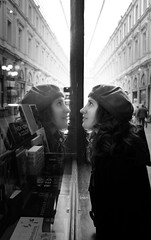Joe’s Reporty Thing – Now at least 80% free of bias!
Last night’s Transmedia London meet-up, was easily the best meet-up I’ve been to since the Book Hackday in May. We (Jon – a designer buddy at Sony, and I) turned up, not quite knowing how many people would be there, or what form the evening would take. It was awesome – we were pleasantly surprised at the number of people, the enthusiasm, and general organisation. It was held at swanky BAFTA HQ, near Picadilly Circus. I’d been there last year for a a great presentation by Peter Molyneux (the closest thing you’ll get to a celebrity video game designer in the UK). The venue was great (although the post-talk networking space was a little too compact for my liking).
Four projects were presented, and all were interesting in their own way…
Andrea Philips talked about America 2049 over skype to the audience, and was blown up on the large cinema screen (As in, her video feed was enlarged. Don’t worry, no writers were sacrificed). The charity ARG project is organised by breakthrough, and was designed to raise awareness of human rights issues. Its central hub is a Facebook game, with impressively high production values – they managed to get some well known actors to work for free to produce video clips to support the narrative. I’m not much of an expert on ARGs though, so I’ll leave you to visit their website if you’re interested: http://america2049.com/
Noam Sohachevsky surprised me, by interesting me in something football related (gosh!). His company, Picklive, makes a type of live fantasy football game. You watch a match on your TV, and simultaneously earn points by betting on real-time events, as they occur, using Picklive’s website. To enter, you pick three players, which you earn points for as they pass, score goals etc, over the course of five minutes. It reminded me of the Apprentice game that the BBC hosted last year. You could make predictions throughout the show on who you thought would be fired, and could see rest of the country’s predictions displayed as a bar chart, which changed in real-time. Although it could be distracting at times, it gave a great sense of community while watching, and the gamification was well integrated.
There was a hint at the psychological theory of attention that was involved in designing a game that can be played on your laptop while watching TV (what did he call it? “dual-screening”?). I guess this is partly what I found so fascinating. Noam showed graphs of the type of attention patterns that you might see while watching a football match compared to watching The Apprentice. There are clear points where a match requires your full attention. For example, as a striker approaches the goal. Compare this with the down-time when the ball goes out of play. If you can synchronise your game design around these patterns, the two screen activities are likely to integrate more seamlessly. The Apprentice is a good example of a show with a very noisy attention graph – high and low points come and go unpredictably. And in fact, this is a problem I found with the BBC’s web-app – it was easy to miss important parts while you diverted your attention to updating your predictions.
I’ll quickly mention the final presentation on The Code – a collaboration between Six to Start and the BBC. Like America 2049, it has high production values. I’m embarrassed to say that I don’t remember enough about this one because I was still thinking and tweeting about Varytale (see below), and each presentation was pretty short! Here’s some info about it though: http://www.sixtostart.com/onetoread/2011/the-code-coming-soon/
The real reason we were there was for Varytale – the upcoming interactive story platform brought to you by the guys who made Echo Bazaar, and was presented by Alexis Kennedy. Their general visual design is lovely – light beiges with modern sans serif for titles, with bookish serifs for body text. The V of their Varytale logo splits into organic branches on one side, echoing the branching narrative. They showed examples of their automated book cover design process. What I wasn’t aware of was that their design algorithm takes into account the relative prestige of the author. Depending on how well rated(?) the writer or their work is, the book cover is automatically designed to have increasing visual distinction and exclusivity. Cool.
I spoke to Alexis briefly afterwards. He’s a nice chap. He emphasised the fact that they’re building a service more than they’re building any particular book or content. They want to create a platform that, in the long term, will be strongly community focused. For now though, they’re aiming it at authors who have capability to produce quality interactive narrative (apparently avoiding an influx of “dark elf slash fiction”). There was a clear emphasis on creating interactive text that won’t alienate non-gamers.
I’m intruiged to see what the initial content offering will look like – are the writers going to be actual proper real life published authors? Or are they going to be specialist hobbyists drawn from communities such as the interactive fiction world? I also wonder exactly how their monetisation system will work – they’re keen to point out that this is a key element of their strategy.
And of course, the biggest question for me is whether there’s a sustainable market, let alone a mass market, for interactive fiction. I really hope so.
Oh yeah, I can also point out that the Varytale business cards look very tasty indeed:









Jul 17, 2011 @ 02:26:02
Noisy Attention Graphs & Co-opting Distraction Media « Ludexed
Jul 19, 2011 @ 05:55:18
» Noisy Attention Graphs & Co-opting Distraction Media Studio Noshoku
Mar 07, 2012 @ 20:48:35
Dual-screening and noisy attention graphs
Mar 31, 2013 @ 00:21:47